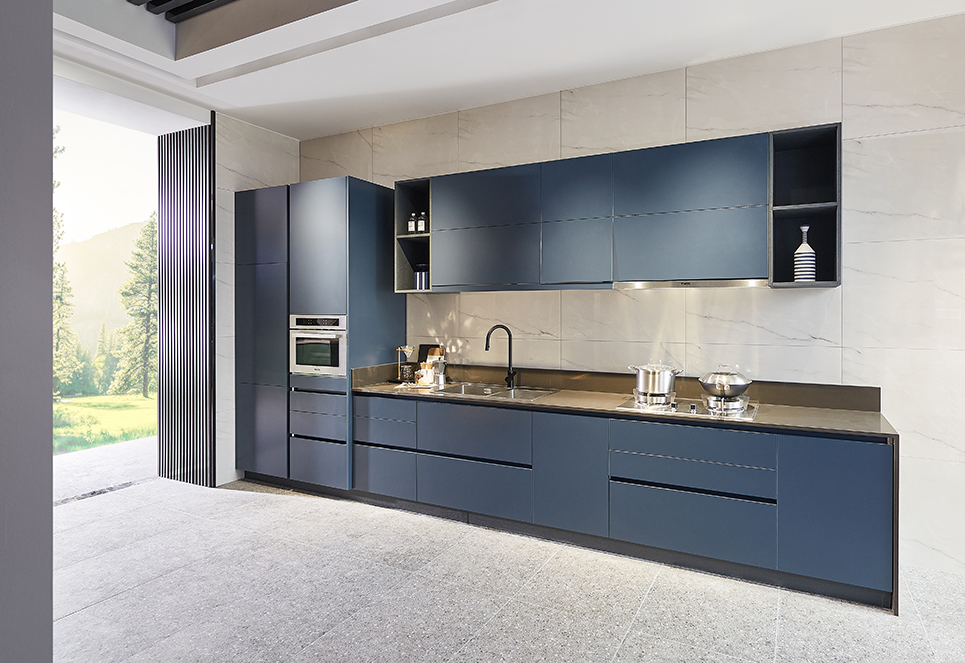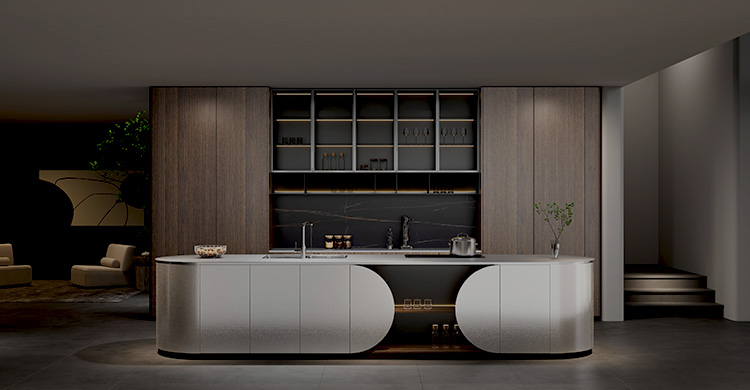Overview of Stainless Steel Cabinets
Stainless steel cabinets are constructed mainly from stainless steel materials. Originally used in commercial kitchens, household stainless steel cabinets became popular in the late 1990s. Their modern aesthetic, durability, and moisture resistance make them a preferred choice for contemporary kitchens. Unlike traditional wooden cabinets, stainless steel cabinets provide a sleek, clean design along with functional advantages.

Cabinet Countertops
Material: The countertop materials include 304 food-grade stainless steel (safe for direct food contact) and 201 stainless steel (not suitable for direct food contact).
Filling: Non-solid countertops typically contain filling materials such as honeycomb aluminum (high-density options offer better impact resistance and load-bearing capacity). Lower-quality fillers include wood boards, PVC boards, foam glue, and steel strips.
Surface Craftsmanship: Various countertop finishes include ordinary, irregular pattern, scratch-resistant, galaxy, rice-grain, crack-textured, brushed, and raindrop-textured surfaces. These finishes are achieved through brushing, roller embossing, and sandblasting techniques.
Cabinet Body
Material: Cabinet bodies are available in both 304 and 201 stainless steel, with interior fillings like honeycomb aluminum, wood boards, PVC boards, and steel strips.
Surface Treatment: Cabinet surface treatments include glass, lacquered, glossy, embossed, leather-textured, and transfer-printed finishes.
Hardware: Key hardware components include rails, hinges, and pull-out baskets. Well-known brands for high-quality cabinet hardware include Blum (Austria), Hettich (Germany), Kesseböhmer (Germany), Salice (Italy), and domestic brands such as HIGOLD and DTC.
Advantages of Stainless Steel Cabinets
Durable and Crack-Free
Stainless steel countertops are designed as a single integrated piece, making them resistant to cracking. They also withstand high temperatures and fire, allowing hot pots and dishes to be placed directly without damage.
Eco-Friendly and Safe
Stainless steel does not contain harmful substances like formaldehyde, which is often found in wooden cabinets. It remains chemically stable and does not release hazardous chemicals.
Easy to Clean and Maintain Shine
The smooth surface allows oil and water stains to be easily wiped away, keeping the countertop looking new. Additionally, it feels cool to the touch, providing a refreshing experience during hot weather.
Excellent Antibacterial Properties
Stainless steel naturally resists bacterial growth, making it an ideal kitchen material for maintaining hygiene.
Stain and Corrosion Resistant
The non-porous surface prevents penetration by oil, sauces, or liquids, making cleaning simple and efficient.
Impact-Resistant and Strong
The high hardness of stainless steel makes it resistant to impacts. Dropped cooking utensils are unlikely to cause significant damage.
Long-Lasting and Fade-Resistant
Unlike other materials that may discolor or fade over time, stainless steel remains bright and corrosion-resistant even after years of use.
Recyclable and Environmentally Friendly
Stainless steel meets environmental standards, has a long lifespan, and can be recycled, reducing environmental impact.
Meets Food Safety Standards
High-quality stainless steel cabinets comply with food-grade safety regulations, ensuring safe usage.
Disadvantages of Common Stainless Steel Cabinets
Cold and Industrial Appearance
Stainless steel’s metallic texture may feel too cold and lack the warmth of wooden cabinets. If you prefer a cozy atmosphere, wooden cabinets might be a better option.
Prone to Scratches
Stainless steel surfaces can be scratched by sharp objects, leading to irreversible marks that may trap dirt over time.
Oxidation Issues
Some domestically produced stainless steel cabinets may oxidize over time, whereas imported stainless steel offers better stability but comes at a higher price.
Solutions for Upgrading Stainless Steel Cabinets
Addressing Cold Appearance: Textured finishes or color steel materials (more expensive) can be used to enhance the visual warmth.
Scratch Resistance: Scratch-resistant surfaces can be applied, preventing damage from knives and forks (higher cost).
Preventing Oxidation: Domestic manufacturers, such as Baosteel, have achieved world-class standards in stainless steel production (higher cost).
Colored Stainless Steel Cabinets
With advancements in stainless steel technology, colored stainless steel sheets have become a new trend in cabinet design. Using vacuum ion plating technology, these sheets come in a variety of colors and textures, such as titanium gold, champagne gold, rose gold, and bronze, catering to diverse kitchen styles.
Fingerprint-Resistant Technology
Nano-coating creates a protective layer that prevents fingerprints and simplifies cleaning.
Enhanced Aesthetic Appeal
Colored stainless steel not only looks stylish but also offers excellent fire resistance, moisture resistance, mold resistance, and corrosion resistance.
Intricate Texture Designs
Advanced equipment can engrave intricate patterns onto the surface, enhancing visual appeal and artistic charm.
Tips for Choosing Stainless Steel Cabinets
Material Selection
The quality of stainless steel directly affects cabinet performance. Common grades include 201, 202, and 304 stainless steel, with 304 being the most durable for long-term use.
Hardware Accessories
The quality of hinges, slides, and other hardware significantly impacts the cabinet’s functionality and longevity. Choose reputable brands for reliable performance.
Craftsmanship and Details
Inspect cabinet edges and sealing strips for fine workmanship, as this enhances durability and prevents leaks.
Environmental Safety
Opt for products that meet environmental standards and food safety requirements.
Noise Reduction Design
High-quality stainless steel cabinets often feature sound-dampening pads or buffers to minimize noise during use.
After-Sales Service
Choose brands with reliable after-sales support to address potential issues during usage.
Cleaning and Maintenance
Daily Cleaning
Wipe surfaces with warm water, soap, or mild detergents. Avoid using strong acidic or alkaline cleaners. Use neutral cleaners for grease removal.
Preventing Scratches
Avoid direct contact with sharp objects to prevent permanent scratches.
Avoiding Chemical Damage
Keep cabinets away from harsh chemicals such as hair dye or paint, and clean any spills immediately.
Proper Usage
Avoid direct contact between hot pots or kettles and the countertop. Use trivets or pads to protect the surface from high temperatures.




